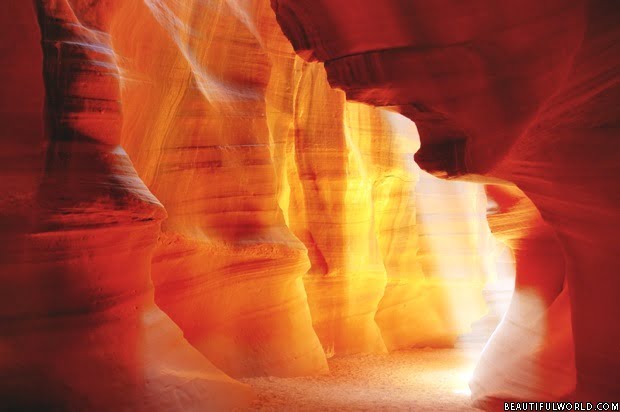Antelope Canyon, set in the southwest region of the United States, is one of the most photographed slot canyons in the world. Located near Page, Arizona, on Navajo land, it is comprised of two distinct sections: The Crack / Upper Antelope Canyon, and The Corkscrew / Lower Antelope Canyon. Of these, The Crack is the most visited due to its flat topography and sunbeam illuminated, sheer sandstone walls. The Corkscrew is less popular with tourists as it’s harder to access, but provides amazing photographic opportunities. It features spiral rock arches that are bathed in muted sunlight, creating breathtaking shades of red and orange that seem to change throughout the day as the sun traverses the sky.
Antelope Canyon Map
Antelope Canyon is on the very Northern border of Arizona just before it becomes Utah. The canyon is located just South East of the town of Page.

Upper Antelope Canyon (The Crack)
The upper canyon is the most photographed are and the most spectacular to visit. Over the summer the canyon experiences spectacular light beams. Things to know;
- You have to visit the canyon on an organised tour.
- You cannot drive to the upper canyon you have to pick up a tour bus from Page.
- You can not visit after heavy rainfall due to the risk of flash floods.
- Light beams are only visible between 11am and 1.30pm when it is sunny from late March to early October.
- If you want to take photos consider paying extra to join a photography tour.
- The canyon is incredibly busy during summer and at weekends, be prepared and book in advance.
- Be aware that there are no toilets or drinks/food outlets at Antelope Canyon.
Lower Antelope Canyon (The Corkscrew)

- You have to visit the canyon on an organised tour.
- You can drive to the lower canyon and join a tour there.
- You can not visit after heavy rainfall due to the risk of flash floods.
- The lower canyon is much quieter than the upper canyon but it has fewer light beams and is not considered to be as spectacular however tours are cheaper.
- There are some fixed ladders which you have to use to visit the canyon so it is not suitable for people with reduced mobility.
- Be aware that there are no toilets or drinks/food outlets at Antelope Canyon.
Antelope Canyon Weather
Temperatures vary from about 6°C (43F) in December/January to 35°C (95F) in July. So it is possible to visit the canyon throughout the year. You should always check an up to date weather forecast before you visit; Winter temperatures can be freezing and the canyon is closed to visitors after heavy rainfall due to the risk of flash flooding. The highest risk of heavy rainfall is during Arizona’s ‘Monsoon Season’ which falls between the middle of June to the middle of September. There are usually other more important criterion to consider before you plan your visit – read on to the next section ‘When to Visit Antelope Canyon’.

When to Visit Antelope Canyon
Antelope Canyon is a very popular place with independent travelers and guided tours, as a result, it is often very busy particularly at weekends. The upper canyon is busier due to the fact access is easier and the terrain flat. If you want your visit to be quiet go early in the day and try to avoid the peak tourist season which runs from June to August.
The upper canyon is heavily photographed and it’s ‘light beams’ are the reason many people visit. These shafts of light are created on clear days when the sun is high in the sky from late March to the start of October. The beams are only visible from about 11am to 1.30pm when it is sunny. The beams are at their best when the sun is directly overhead (June – August) and as a result, this is when the canyon receives most visits. There are some special photography tours you can join – see next section ‘Antelope Canyon Tours’.
The lower canyon is harder to reach and involves a hard ladder climb so this part of the canyon is always much quieter. Note the lower canyon does not experience anything like as many light beams.
Antelope Canyon Tours
You can only visit the upper and lower canyons on official tours. You can drive to the lower canyon but for the upper canyon to have to pick up your tour transport from Page. You will need to pay an $8 fee to enter the Navajo Park and the tour will be $30 – $65 on top.
Several tour operators run special photography tours of the upper canyon for about $110. You are only allowed to use a camera tripod if you are on one of these tours. The tour guides keep the crowds back so the people on the tour can take some special pictures. Given how busy the canyon is attending one of these tours is really the only way to get great photos of the light beams.
Navajo Tours is a tour company that is run exclusively by people from the local Navajo population and is rated highly for the quality and price of tours.
Page is just round the corner from the spectacular Horseshoe Bend and you can choose to go on a combined tour to see both locations.











its pretty
no
fair enough
can ya tell about how big it is?
like the length?
about 3,704 feet high
This Canyon is so beautiful that I’m researching it for a projet
Same!
same !
same!
I went there and it was the best thing I ever saw
its so beautiful that i can feel it coming inside me 😳